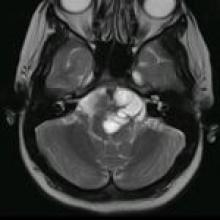Posterior Fossa Pilocytic Astrocytoma without Gangliocytic Differentiation
- Background:
- Pilocytic astrocytoma (PA) is a low-grade pediatric glioma and the most common pediatric brain tumor, accounting for 5–6% of all pediatric brain tumors.
- It is a WHO grade I tumor. It can arise anywhere in the CNS, but is most commonly localized in the cerebellum.
- Almost all PAs contain a KIAA1549-BRAF fusion, and this alteration differentiates PAs from gangliogliomas with high specificity. Pilocytic astrocytomas almost never progress to higher-grade astrocytomas, dissemination occurs only in extremely rare cases, and overall survival rates are excellent.
- Two histopathologic variants of PA are described. One is with gangliocytic differentiation and the other is without gangliocytic differentiation.
- The gangliocytic differentiation prognosis is relatively poor.
- The variants can now be differentiated on the basis of MRI of the brain, as well as histopathology.
- PA without gangliocytic differentiation involves more off-the-midline structures, with relative ADC values >1.22, whereas gangliocytic variants are usually located within midline structures, with relative ADC values <1.22.
- Pilocytic astrocytoma (PA) is a low-grade pediatric glioma and the most common pediatric brain tumor, accounting for 5–6% of all pediatric brain tumors.
- Clinical Presentation:
- Presents with variable symptoms depending on the areas of involvement
- Key Diagnostic Features:
- PA typically appears as a well-circumscribed tumor, often as a cystic lesion with an enhancing mural nodule, within the posterior fossa. There is usually no significant associated edema.
- PA without gangliocytic differentiation involves more off-the-midline structures (cerebellar hemispheres and middle cerebellar peduncle).
- ADC maps are also very useful; relative ADC values >1.22 may indicate the absence of gangliocytic differentiation
- Differential Diagnoses:
- PA with gangliocytic differentiation: Usually midline structures (brain stem) with relative ADC values <1.22
- Ganglioglioma: Usually solid with less exophytic component
- Diffuse intrinsic pontine glioma: Diffuse, poorly marginated tumor with brain stem expansion and no enhancement
- Embryonal tumors: Derived from embryonal cells and consist of medulloblastomas, primitive neuroectodermal tumors, and atypical teratoid/rhabdoid tumors (AT/RT); ususully solid with variable enhancement and diffusion restriction
- Treatment:
-
The current standard of care includes maximal safe resection where possible and chemotherapy and/or irradiation. Vincristine and carboplatin are the most commonly used chemotherapeutic agents.
-







